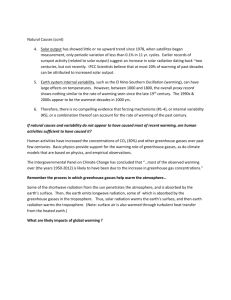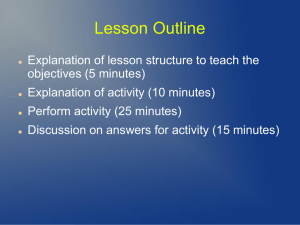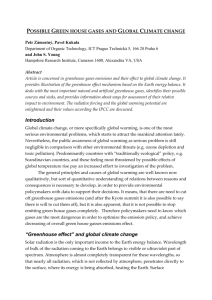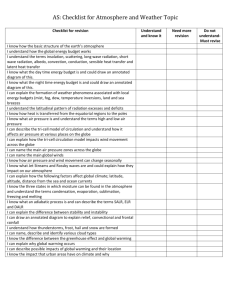Lesson plan - KBS GK12 Project
advertisement
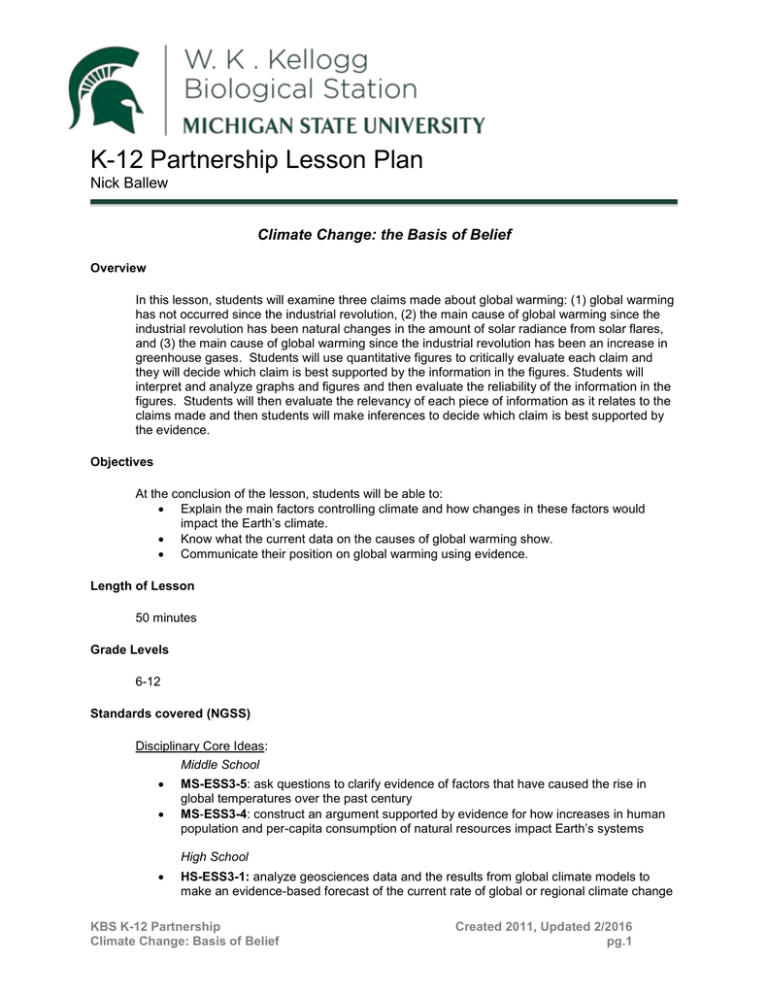
K-12 Partnership Lesson Plan Nick Ballew Climate Change: the Basis of Belief Overview In this lesson, students will examine three claims made about global warming: (1) global warming has not occurred since the industrial revolution, (2) the main cause of global warming since the industrial revolution has been natural changes in the amount of solar radiance from solar flares, and (3) the main cause of global warming since the industrial revolution has been an increase in greenhouse gases. Students will use quantitative figures to critically evaluate each claim and they will decide which claim is best supported by the information in the figures. Students will interpret and analyze graphs and figures and then evaluate the reliability of the information in the figures. Students will then evaluate the relevancy of each piece of information as it relates to the claims made and then students will make inferences to decide which claim is best supported by the evidence. Objectives At the conclusion of the lesson, students will be able to: Explain the main factors controlling climate and how changes in these factors would impact the Earth’s climate. Know what the current data on the causes of global warming show. Communicate their position on global warming using evidence. Length of Lesson 50 minutes Grade Levels 6-12 Standards covered (NGSS) Disciplinary Core Ideas: Middle School MS-ESS3-5: ask questions to clarify evidence of factors that have caused the rise in global temperatures over the past century MS-ESS3-4: construct an argument supported by evidence for how increases in human population and per-capita consumption of natural resources impact Earth’s systems High School HS-ESS3-1: analyze geosciences data and the results from global climate models to make an evidence-based forecast of the current rate of global or regional climate change KBS K-12 Partnership Climate Change: Basis of Belief Created 2011, Updated 2/2016 pg.1 and associated future impacts to Earth systems Cross Cutting Concepts: Patterns Cause and effect Systems and system models Stability and change of systems Science and Engineering Practices Analyzing and interpreting data Engaging in argument from evidence Obtaining, evaluating, and communicating information Previous Michigan Standards Met: P.EN.06.41: Explain how different forms of energy can be transferred from one place to another by radiation, conduction, or convection. L.EC.06.41: Describe how human beings are part of the ecosystem of the Earth and that human activity can purposefully, or accidentally, alter the balance in ecosystems. E.ES.07.42: Describe the origins of pollution in the atmosphere, geosphere, and hydrosphere, (car exhaust, industrial emissions, acid rain, and natural sources), and how pollution impacts habitats, climatic change, threatens or endangers species. E5.4A: Explain the natural mechanism of the greenhouse effect, including comparisons of the major greenhouse gases (water vapor, carbon dioxide, methane, nitrous oxide, and ozone). E5.4C: Analyze the empirical relationship between the emissions of carbon dioxide, atmospheric carbon dioxide levels, and the average global temperature over the past 150 years. E5.4g: Compare and contrast the heat-trapping mechanisms of the major greenhouse gases resulting from emissions (carbon dioxide, methane, nitrous oxide, fluorocarbons) as well as their abundance and heattrapping capacity. B3.4C: examine the negative impact of human activities B3.4d: describe the greenhouse effect and list possible causes B3.4e: list the possible causes and consequences of global warming Materials ● ● Powerpoint Handout containing data for evaluating claims (found on the “Climate Change: Basis of Belief” lesson page on the KBS GK-12 website) Background The climate system is a complex, interactive system consisting of the atmosphere, land surface, snow and ice, oceans and other bodies of water. The atmospheric component of the climate system most obviously characterizes climate; climate is often defined as ‘average weather’. Climate is usually described in terms of the mean and variability of temperature, precipitation and wind over a period of time, ranging from months to millions of years (the classical period is 30 years). Solar radiation powers the climate system. There are three fundamental ways to change the radiation balance of the Earth: 1) by changing the incoming solar radiation (changes in Earth’s orbit or in the Sun itself), 2) by changing the fraction of solar radiation that is reflected (changes in cloud cover or atmospheric particles), and 3) by altering the longwave radiation from Earth back towards space (changing greenhouse gas concentrations). Climate, in turn, responds directly to such changes, as well as indirectly, through a variety of feedback mechanisms. The climate system evolves in time due to changes in external factors that alter the radiation balance of earth (called ‘external forcings’ and described above) and its own internal dynamics. External forcings include natural phenomena such as volcanic eruptions and solar variations, as well as humaninduced changes in atmospheric composition. KBS K-12 Partnership Climate Change: Basis of Belief Created 2011, Updated 2/2016 pg.2 The amount of energy reaching the top of Earth’s atmosphere each second on a surface area of one square meter facing the Sun during daytime is about 1,370 Watts, and the amount of energy per square meter per second averaged over the entire planet is one-quarter of this (see Figure 1). About 30% of the sunlight that reaches the top of the atmosphere is reflected back to space. Roughly two-thirds of this reflectivity is due to clouds and small particles in the atmosphere known as ‘aerosols’. Light-colored areas of Earth’s surface – mainly snow, ice and deserts – reflect the remaining one-third of the sunlight. The most dramatic change in aerosol-produced reflectivity comes when major volcanic eruptions eject material very high into the atmosphere. Rain typically clears aerosols out of the atmosphere in a week or two, but when material from a violent volcanic eruption is projected far above the highest cloud, these aerosols typically influence the climate for about a year or two before falling into the troposphere and being carried to the surface by precipitation. The energy that is not reflected back to space is absorbed by the Earth’s surface and atmosphere. This amount is approximately 240 Watts per square meter (W m–2). To balance the incoming energy, the Earth itself must radiate, on average, the same amount of energy back to space. The Earth does this by emitting outgoing longwave radiation. Everything on Earth emits longwave radiation continuously. That is the heat energy one feels radiating out from a fire; the warmer an object, the more heat energy it radiates. To emit 240 W m–2, a surface would have to have a temperature of around –19°C. This is much colder than the conditions that actually exist at the Earth’s surface (the global mean surface temperature is about 14°C). Instead, the necessary –19°C is found at an altitude about 5 km above the surface. The reason the Earth’s surface is this warm is the presence of greenhouse gases, which act as a partial blanket for the longwave radiation coming from the surface. This blanketing is known as the natural greenhouse effect. The most important greenhouse gases are water vapor and carbon dioxide. The two most abundant constituents of the atmosphere – nitrogen and oxygen – have no such effect. Clouds, on the other hand, do exert a blanketing effect similar to that of the greenhouse gases; however, this effect is offset by their reflectivity, such that on average, clouds tend to have a cooling effect on climate (although locally one can feel the warming effect: cloudy nights tend to remain warmer than clear nights because the clouds radiate longwave energy back down to the surface). There are many feedback mechanisms in the climate system that can either amplify (‘positive feedback’) or diminish (‘negative feedback’) the effects of a change in climate forcing. For example, as the earth warms from some external forcing, snow and ice would begin to melt. This melting would reveal darker land and water surfaces that were beneath the snow and ice, and these darker surfaces would absorb more of the Sun’s heat, causing more warming, which would cause more melting, and so on, in a self-reinforcing cycle. Activities of the session 1. Use powerpoint to introduce the activity 2. Introduce the three claims students will investigate: (1) global warming has not occurred since the time of the industrial revolution; (2) the main cause of global warming from the time of the industrial revolution to the present has been natural changes in the amount of solar radiance from solar flares; (3) the main cause of global warming from the industrial revolution to the present has been an increase in greenhouse gases in the atmosphere during that time. 3. Students work individually or in groups up to four to examine information provided in the handout and relate it to the claims 4. Students decide which claim they support based on given information, justify position based on evidence, explain what additional information might be needed to convince them of claim 5. Discussion on answers for activity KBS K-12 Partnership Climate Change: Basis of Belief Created 2011, Updated 2/2016 pg.3 Resources Lesson powerpoint Student handout Student handout answer sheet (found of “Climate Change: Basis of Belief” lesson page on the KBS GK-12 website) KBS K-12 Partnership Climate Change: Basis of Belief Created 2011, Updated 2/2016 pg.4




